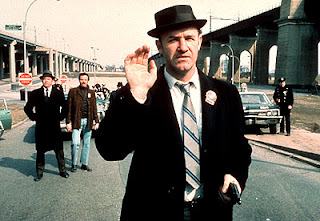...Caché
(2005): This wonderfully unsettling psychological thriller from
Michael Haneke, deconstructs the supercomfortable middle-class wolrd
of Daniel Auteuil, menaced by a hidden observer with a surveillance
camera. Terrible truths are, inevitably, revealed. Being a film about
well-heeled French domestic life - however threatened - it also
contains several eating and drinking moments, and some handsome red
wines: one of the absolute cornerstones of French culture, invisibly
corrupted, as it turns out, by the invisible presence of Auteuil's
stalker. That's how dreadful the threat is: even the innocent,
pleasurable, wine becomes a part of it. So what antidote can there be
to this existential terror?
Carry
On Up The Khyber
(1968): Best of the Carry
Ons
by a considerable margin, not least because of the celebrated
sequence at the end of the film in which Sid James, Joan Sims and
the rest, plough (with full decorations) through a formal British Raj
dinner, under heavy bombardment from an army of enraged tribesmen led
by the Khasi of Kalabar (Kenneth Williams) and his lieutenant,
Bungdit Din (Bernard Bresslaw). Bottles explode with shot, the
chandelier crashes from the ceiling onto the table centrepiece, the
orchestra is hit by a mortar shell, but the civilities never waver -
not least in the the consoling and civilising presence of fine wines,
a countervailing force against the dark barbarism outside. Clarets,
from the look of them. Lady Ruff-Diamond (Sims), picking a chunk of
ceiling from her pompadour hairstyle: 'Oh dear! I seem to have got a
little plastered!'
Bicycle
Thieves
(1948): But what if you
are the outsider? What if you are marginalised - like the father and
son in Vittorio de Sica's masterpiece? Wine becomes implicated in
your misfortune, an index, even, of your poverty and despair. Father
(Lamberto Maggiorani) treats son (Enzo Staiola) to a restaurant meal
with wine, a consolation for their latest round of misfortunes.
'Let's forget everything and get drunk!' he cries. But the next table
is occupied by a family of gallingly prosperous suburban Romans.
Their wine is plentiful and arrives in smart bottles with labels; the
father and son's comes in a greasy blank carafe. The father's good
mood begins to slip away. Within minutes, he is compulsively
rehashing the events that have led to his downfall - the theft of his
bike, mainly - and outlining the humiliation that threatens to
overwhelm them. The wine is a false friend, confirming the mood,
rather than banishing it. 'We'll find it,' says the son, braver than
his father, 'we'll go every day to the Porta Portese'. Do they get
drunk? No. But Dumbo does.
Dumbo
(1941): This is one which Disney himself had to finish off, when most
of his studio went on strike. It is also the one in which Dumbo and
his friend, Timothy Mouse, accidentally get soused on some leftover
grog - resulting in the authentically troubling Pink
Elephants On Parade
sequence. As anyone with children will tell you, this is one of the
hardest episodes in a cartoon film to explicate to a four-year-old -
harder, in its way, than the death of Bambi's mother or the
surprising uselessness of The
Jungle Book.
Its vertiginous transformations and distortions (multicoloured devil
elephants, amoebal ghost elephants) have something of the Little Nemo
cartoons, but without the charm; while the atmosphere of sick menace
is as bad as anything from Max Fleischer. This is not drink as we
know it. This is a trip to the pharmacopeia, and one which tells you
a lot about America's grimly conflicted relationship with drink and
self-loathing. Not entirely dispelled by
The
French Connection
(1971): Another great film: William Friedkin's best, Gene Hackman's
best, an unimprovable car chase, and a terrific stake-out sequence
with Popeye Doyle (Hackman) freezing his butt off as he watches bad
guy Charnier (Fernando Rey) tuck into a gourmet meal in a discreetly
sumptuous New York restaurant (actually the Copain). Hackman gnaws a
congealing pizza and blows on his chapped fingers; Rey luxuriates in,
yes, a fine wine, a wine whose very fineness indicates how terrible
and heartless he can be. This is wine as metaphor for evil - rather a
remorseless depiction, especially from the country which gave us Dean
Martin, but there you are. There is no necessary benevolence in the
drink after all - only the capacity to take on a moral colour from
whatever its surroundings happen to be. Which leads us handily back
to the bottle on the sleek Parisan
dining
table...
CJ

No comments:
Post a Comment
Note: only a member of this blog may post a comment.